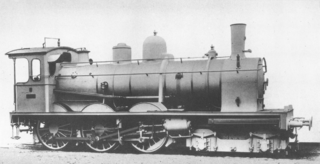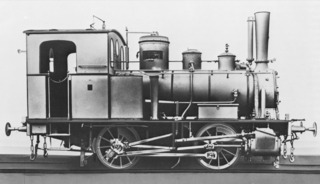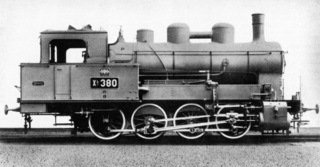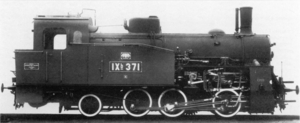The steam engines of Class G 4/5 H operated by the Royal Bavarian State Railways were the most powerful of the German, 2-8-0, freight locomotives.
The Bavarian Class PtzL 3/4 engines with the Royal Bavarian State Railways were rack railway locomotives whose cogwheel drive was designed for working on tracks with a Strub rack. In 1923 they were incorporated by the Deutsche Reichsbahn as DRG Class 97.1 in their numbering plan. The locomotives remained on their regular route between Erlau and Wegscheid until the closure of this rack railway in 1963. The last journey was on 5 January 1963. They were scrapped in April 1964 at Simbach am Inn.

The Württemberg Hz were 0-10-0 rack and adhesion steam locomotives, that were initially developed by the Royal Württemberg State Railways, but were delivered to the Deutsche Reichsbahn-Gesellschaft (DRG) in the mid-1920s.

The Prussian G 12 is a 1'E 2-10-0 goods train locomotive built for the Prussian state railways.

The first steam locomotives of the Baden Class VI c were delivered in 1914 by the Maschinenbau-Gesellschaft Karlsruhe for service in southwestern Germany with the Grand Duchy of Baden State Railway.
The Oldenburg T 2 steam locomotives were German 0-4-0 tank engines built between 1896 and 1913 for the Grand Duchy of Oldenburg State Railways. They were designed for use on branch lines. A total of 38 units were produced, based on a Prussian T 2 prototype and differing only in the boiler fittings. Unlike their Prussian cousins, they had no steam dome and the regulator was located in the smokebox. Its permitted top speed of 50 km/h was also higher than the Prussian version.
The Prussian T 13 was a series of tank locomotives built in large numbers for the various German state railways, notably the Prussian state railways, and the Deutsche Reichsbahn during the early part of the 20th century.

The locomotives of Baden Class IV e were designed and built for the Grand Duchy of Baden State Railway in the late 19th century by the Elsässischen Maschinenbau-Gesellschaft Grafenstaden, who supplied the first eight examples in 1894. They were the first locomotives in Germany with a 4-6-0 wheel arrangement. Another 75 locomotives were built up to 1901 by the Maschinenbau-Gesellschaft Karlsruhe.

The Baden VI b was the first German tank locomotive with a 2-6-2 wheel arrangement. It was developed by the firm of Maffei for the Grand Duchy of Baden State Railways in order to provide faster services on the Höllentalbahn. As a result, the first six batches were given a firebox sloping to the rear. One striking feature was also the connecting pipe between the two steam domes.

The Baden Class I e locomotives with the Grand Duchy of Baden State Railways were twin-axled tank engines that were built by the Maschinenbaugesellschaft Karlsruhe for duties on branch lines.
The Baden Class I b locomotives of the Grand Duchy of Baden State Railways were built for the pontoon bridges from Heidelberg to Speyer. Altogether three of these engines were on duty, of which two had been taken over from the Palatinate Railway in 1874. A third machine was procured directly from the Maschinenbau-Gesellschaft Karlsruhe in 1893.

The Baden X b of the Grand Duchy of Baden State Railway was a goods train tank locomotive with a 0-8-0T wheel arrangement.
The Class T 3s of the Grand Duchy of Oldenburg State Railways were tank locomotives for duties on local and branch lines. They were broadly similar to the Prussian T 3. In terms of performance they were no different from the Oldenburg T 2; but the T 3 had a lower axle load and a somewhat higher adhesive weight of 4.4 tonnes.
The steam locomotives of Oldenburg Class B of the Grand Duchy of Oldenburg State Railways were built in the early 1900s for working the metre gauge network on the German island of Wangerooge.
The Mecklenburg Class G 3 was an early German steam locomotive operated by the Grand Duchy of Mecklenburg Friedrich-Franz Railway. Formerly the Class IX it was a copy of the Prussian G 3.
DRG Class 97 is a class of German rack railway steam locomotive operated by the Deutsche Reichsbahn comprising:
The Prussian G 4.2 was a class of compound 0-6-0 goods locomotive of the Prussian State Railways. It was a compound version of the G 3 and G 4.1 types by Henschel.







